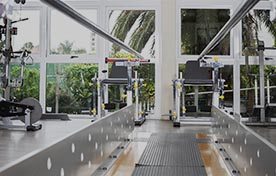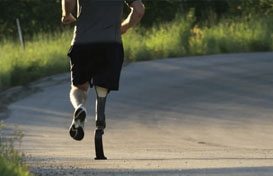by John Peter Seaman, CP, CTP

As a recent amputee, you’re not alone if you feel clueless about what to expect during your first year as an amputee. While there are no set guidelines that will fit every amputee’s individual situation, there are some generalities that may apply. One certainty is that you will see your prosthetist many times during your first year as an amputee, possibly as many as 15 to 20 times, if not more. For this reason, you should do everything in your power to find a prosthetist that you are comfortable with.
![]() Following your amputation, you and your residual limb will start your respective psychological and physical healing processes. Depending on how fast your limb heals, you should expect to have your stitches/staples removed within 3 to 4 weeks of your surgery. You should start pre-prosthetic physical therapy soon after your amputation, working on your upper body strength and your lower limbs to maintain good range of motion in your hips and knees and strength in your leg muscles. You should also start desensitizing your residual limb by rubbing it and manually moving your tissue around with your hands to loosen any scar tissue that might develop inside your limb. You will also meet your prosthetist multiple times, first for a consultation/evaluation and then to be fitted with a “stump shrinker” (an elastic stocking) that will start shaping your residual limb for initial prosthetic fitting.
Following your amputation, you and your residual limb will start your respective psychological and physical healing processes. Depending on how fast your limb heals, you should expect to have your stitches/staples removed within 3 to 4 weeks of your surgery. You should start pre-prosthetic physical therapy soon after your amputation, working on your upper body strength and your lower limbs to maintain good range of motion in your hips and knees and strength in your leg muscles. You should also start desensitizing your residual limb by rubbing it and manually moving your tissue around with your hands to loosen any scar tissue that might develop inside your limb. You will also meet your prosthetist multiple times, first for a consultation/evaluation and then to be fitted with a “stump shrinker” (an elastic stocking) that will start shaping your residual limb for initial prosthetic fitting.
![]() Once your incision has completely healed, your stitches have been removed and your doctor has provided a prescription for a preparatory prosthesis, you will meet with your prosthetist to be measured and “cast.” Depending on how your prosthetist works, he or she will either cast your residual limb or create a digital image of it by scanning or taking pictures of it. Once your prosthetist has a positive model of your limb, it will be used to create a diagnostic (check or test) socket for test fitting purposes. This socket will be connected to a knee (for transfemoral amputees) or just a pylon (for transtibial amputees), which in both cases will then be connected to a prosthetic foot. When you see your prosthetist for a test fitting, this might be completed in one visit or it could take multiple visits. Once a diagnostic socket is deemed to fit “comfortably,” your preparatory socket will be fabricated and connected to your other prosthetic componentry, resulting in your first prosthesis. Adjustments to this prosthesis may be required during the first month or two that you wear it, leading to follow-up visits to your prosthetist. After you are fitted with your first prosthesis, your doctor should provide a prescription for physical therapy. Usually, you will see a physical therapist two to three times a week for 1-hour sessions. These sessions are important to ensure that you develop good habits while you relearn how to walk, using a prosthesis. You will typically start walking using a walker as you work to regain strength, balance, endurance and confidence.
Once your incision has completely healed, your stitches have been removed and your doctor has provided a prescription for a preparatory prosthesis, you will meet with your prosthetist to be measured and “cast.” Depending on how your prosthetist works, he or she will either cast your residual limb or create a digital image of it by scanning or taking pictures of it. Once your prosthetist has a positive model of your limb, it will be used to create a diagnostic (check or test) socket for test fitting purposes. This socket will be connected to a knee (for transfemoral amputees) or just a pylon (for transtibial amputees), which in both cases will then be connected to a prosthetic foot. When you see your prosthetist for a test fitting, this might be completed in one visit or it could take multiple visits. Once a diagnostic socket is deemed to fit “comfortably,” your preparatory socket will be fabricated and connected to your other prosthetic componentry, resulting in your first prosthesis. Adjustments to this prosthesis may be required during the first month or two that you wear it, leading to follow-up visits to your prosthetist. After you are fitted with your first prosthesis, your doctor should provide a prescription for physical therapy. Usually, you will see a physical therapist two to three times a week for 1-hour sessions. These sessions are important to ensure that you develop good habits while you relearn how to walk, using a prosthesis. You will typically start walking using a walker as you work to regain strength, balance, endurance and confidence.
![]() Your residual limb will continue to go through physiological changes as you use your prosthesis more, typically resulting in volume loss. If your rehabilitation process proceeds well, you might see your prosthetist on a monthly or bimonthly basis during this time period. It might become necessary for your prosthetist to fit you with a socket replacement during this timeframe due to significant volume loss in your residual limb, which can cause your original preparatory socket to become too large and adversely affect its fit. If so, you may be test fit again before you are fitted with another downsized laminated socket. This process can take a few visits to your prosthetist to complete. Be aware that every socket you are fit with will feel different, which may require some getting used to and possible adjustments following fitting. If your rehabilitation has proceeded well to this point, you might not need continued physical therapy.
Your residual limb will continue to go through physiological changes as you use your prosthesis more, typically resulting in volume loss. If your rehabilitation process proceeds well, you might see your prosthetist on a monthly or bimonthly basis during this time period. It might become necessary for your prosthetist to fit you with a socket replacement during this timeframe due to significant volume loss in your residual limb, which can cause your original preparatory socket to become too large and adversely affect its fit. If so, you may be test fit again before you are fitted with another downsized laminated socket. This process can take a few visits to your prosthetist to complete. Be aware that every socket you are fit with will feel different, which may require some getting used to and possible adjustments following fitting. If your rehabilitation has proceeded well to this point, you might not need continued physical therapy.
![]() By now, your residual limb may have stopped shrinking and reached a somewhat mature state. At this point, your physician might prescribe that you be fit with your definitive (final or permanent) prosthesis, assuming your preparatory socket no longer fits intimately. This may require test fitting again and additional visits to your prosthetist before a new laminated socket is fabricated. Your prosthetist will also incorporate componentry into your definitive prosthesis that matches your current and/ or potential level of activity, assuming your activity level has changed since originally being fit with your preparatory prosthesis. You may have progressed through the use of a variety of assistive devices (walker to a 4-prong cane to a single-prong cane) to the point where you can ambulate without an assistive device. However, not all lower-limb amputees are able to function safely without the use of an assistive device, depending on their overall health, determination and confidence. Be aware that for some amputees, prolonged use of an assistive device can enhance safety and reduce the potential for falls.
By now, your residual limb may have stopped shrinking and reached a somewhat mature state. At this point, your physician might prescribe that you be fit with your definitive (final or permanent) prosthesis, assuming your preparatory socket no longer fits intimately. This may require test fitting again and additional visits to your prosthetist before a new laminated socket is fabricated. Your prosthetist will also incorporate componentry into your definitive prosthesis that matches your current and/ or potential level of activity, assuming your activity level has changed since originally being fit with your preparatory prosthesis. You may have progressed through the use of a variety of assistive devices (walker to a 4-prong cane to a single-prong cane) to the point where you can ambulate without an assistive device. However, not all lower-limb amputees are able to function safely without the use of an assistive device, depending on their overall health, determination and confidence. Be aware that for some amputees, prolonged use of an assistive device can enhance safety and reduce the potential for falls.
![]() As you approach the end of the first year since your amputation, you will hopefully have become fairly comfortable with life as an amputee: You will have mastered using a prosthesis – putting it on (donning), taking it off(doffing), making adjustments to the number of socks being worn, etc.; your phantom pain will have subsided and your phantom sensations will have lessened or become more tolerable; you will have found that you are able to do many of the activities of daily living (ADLs) that you did prior to your amputation, but possibly in different ways; and you will have established a good relationship with your prosthetist, who you’ve seen many times during the past year and will continue to see on a
As you approach the end of the first year since your amputation, you will hopefully have become fairly comfortable with life as an amputee: You will have mastered using a prosthesis – putting it on (donning), taking it off(doffing), making adjustments to the number of socks being worn, etc.; your phantom pain will have subsided and your phantom sensations will have lessened or become more tolerable; you will have found that you are able to do many of the activities of daily living (ADLs) that you did prior to your amputation, but possibly in different ways; and you will have established a good relationship with your prosthetist, who you’ve seen many times during the past year and will continue to see on a
regular basis in the future.
If you have any questions about this article, please contact John Peter Seaman at jpseaman@aol.com.
Disclaimer: The following information is provided and owned by the Amputation Coalition of America and was previously published on the website http://www.amputee-coalition.org or the Coalitions Newsletter, inMotion.








